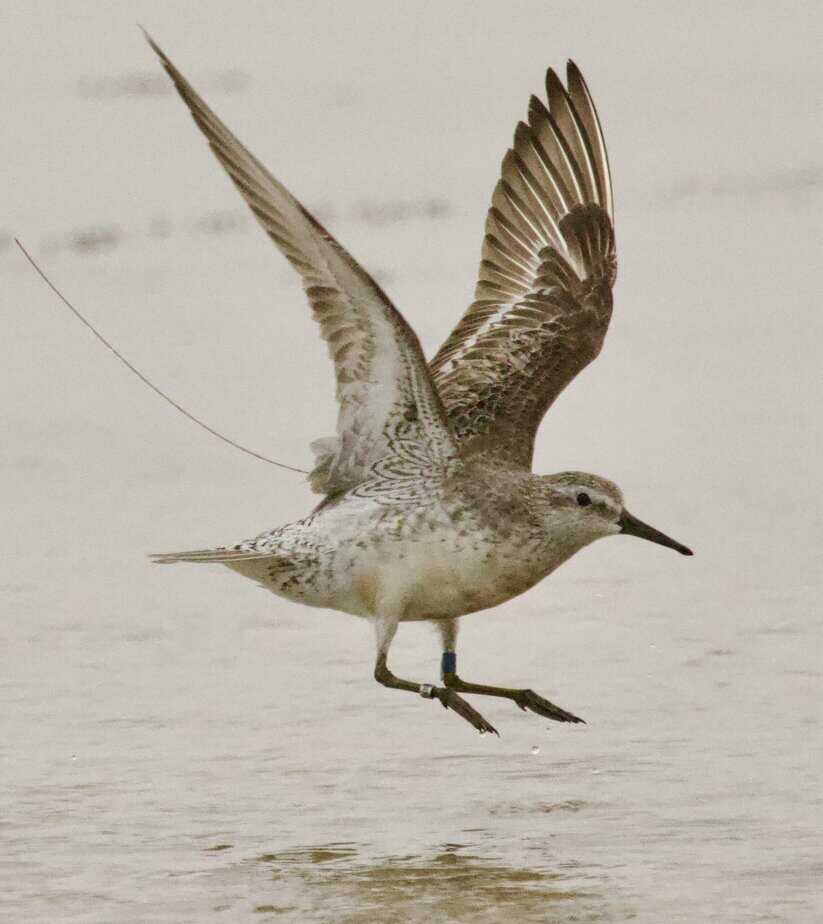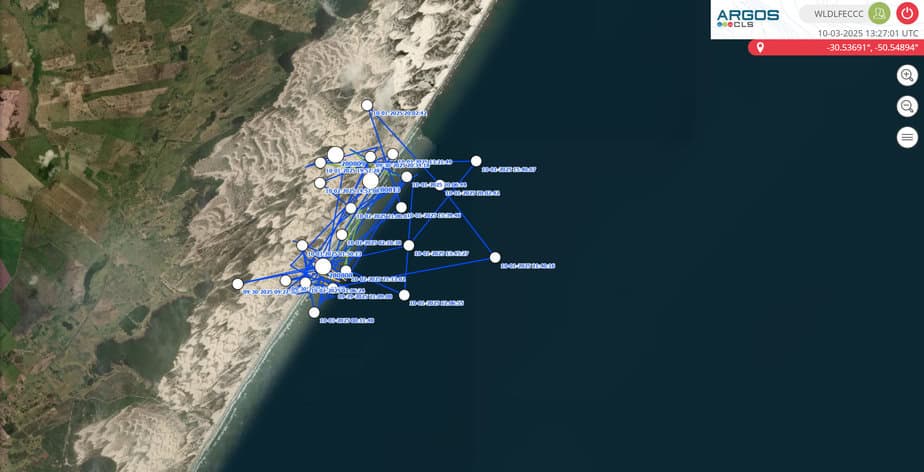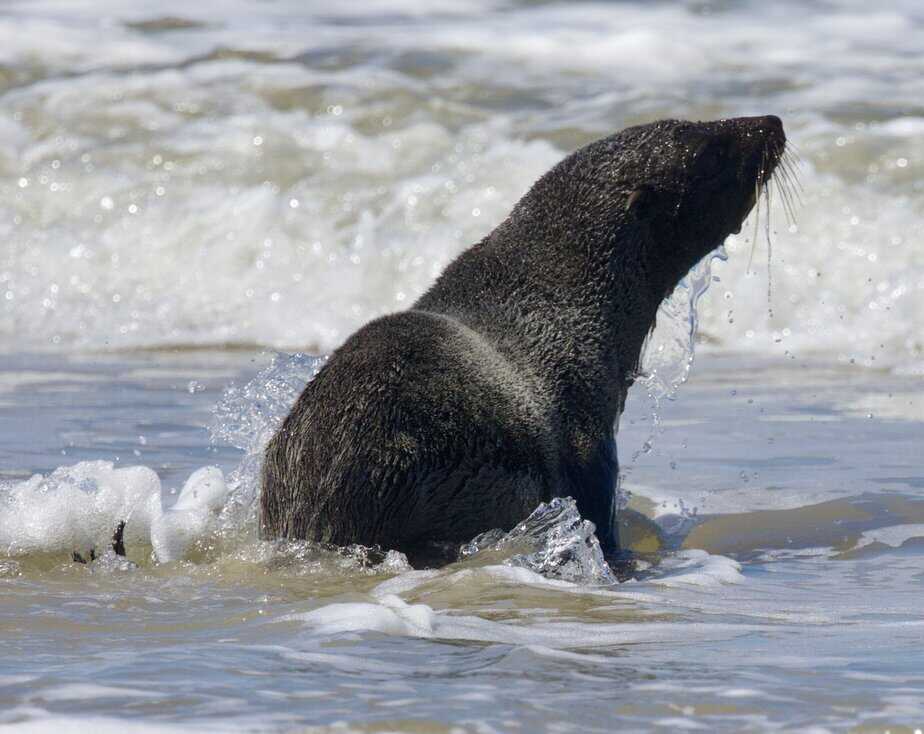A Ground Game

A red knot with a satellite transmitter in Lagoa do Piexe National Park in Brazil
When we began our work in LDP, the goal was to catch birds here, so we could track them along their wintering areas in Argentina and Chile. Those locations pose significant challenges to fieldwork, finding cooperative partners and procuring black powder chief among them. We believed that if we tagged red knots in LDP, we could avoid the difficulties encountered elsewhere and gain a more comprehensive view of all wintering areas in the Southern Cone of South America. However, trapping in LDP is challenging, and after a week of effort, we have only tagged 6 birds.

Stephanie Feigin and Theo Diehl attached a Sunbird Satelilite Transmitter to a red knot caught on LDP
Antonio Brum releases a red knot tagged with a satellite transmitter
It’s not due to the lack of expertise or the lack of trying. Ours is a team that has captured more red knots, and probably more shorebirds overall, than most research teams in the world. Unfortunately, the problem we face is that we are running against the ecological grain of this complicated species.While trapping we met the staff of ICMBio the government agency managing the Park. I describe ICMBio in our work in Northern Brazil in this earlier post

Our team in Lagoa do Piexe with staff of ICMBio, the Brazilian goverment agency managing the park. I wrote of the agency and thier ground breaking work placing rural communities first in the use of natural resources. The Brazilan management of natural resources needs more funding but in concept it is a superior method when compared to US natural resource use which prioritise industry instead of local communities see post here
Our previous expeditions took place in the North American spring, aiming to capture birds before they traveled to their Arctic breeding grounds. This was our main goal for the project funded by the Canadian Wildlife Service and Environment Canada. We tagged nearly a hundred red knots with satellite transmitters provided by the two agencies, and the results offer one of the most comprehensive and detailed views of red knot breeding areas in the Arctic of any shorebird. Moreover, tagging birds in LDP flying from wintering areas in the Southern Cone of South America gave us a detailed picture of this most endangered segment of red knots. Knots came to LDP to build weight, some reaching 240 grams, double the fat free weight of a red knot to make flights that could last 7 days at once. This sub-population once numbered 65,000 birds. Now, only about 15,000 remain.

Red knots photographed by Antonio Brum near the end of the fall (northbound) stopover in Lagoa do Piexe Brazil
The abundant supply of bivalves here kept the birds in LDP long enough to catch and tag them. But now, we are aiming to catch birds in a Brazilian spring of constant sensory delight. Orchids blooming on a giant fig tree, a meowing cat frog singing an eerie song, and giant daisies gracing the coastal dunes, while red knots fly south to their wintering areas in Tierra del Fuego. We thought the catch would be bountiful here, but our experience has proven otherwise.
Why?
Because at this point in their 10,000-mile migration, the birds have already passed through the gauntlet of the U.S. coast, Atlantic Ocean crossing, and Amazonia. Having survived that daunting ordeal, the birds could now feel relatively safe enough to keep their weight to a minimum. They no longer need vast stores of fat to cover the rest of their journey, because most of the coast from LDP to Chile is good foraging habitat. Like people, birds prefer to stay trim, although for entirely different reasons. A lean weight gives them a better chance to avoid the talons of avian predators such as aplomado falcons. It’s a basic tenet of shorebird biology: more weight helps when food supplies are uncertain, but at the same time, it increases the risk of predation. Lower weight allows a better defense against predators, but it also poses a greater risk of starvation. Agencies like N.J. Fish and Wildlife ignore this when they encourage peregrine falcons to nest along Delaware Bay, where peregrines were never meant to nest. The result: a shorebird buffet for falcons feasting on shorebirds trying to build weight to reach their Arctic nesting grounds.

a pergrine falcon on Delaware Bay
In other words, the birds don’t need to build weight here, and they very likely move quickly from place to place. Plus, you only see them in low numbers. If you were to add them all up over the entire migration season, from September to December, they will number in the thousands. But on any given day, the birds are few and far between. We surveyed nearly 100 kilometers of wild beach, populated by only a few small villages and wildness unlike any other coastline I have seen. In this entire stretch we counted just 50 red knots. Small numbers but still we have 6 birds with sat transmitters pumping out data that can be used to understand knots and this wonderful stopover.

Location of red knots tagged with Satellite transmitters north of the Praia do Farol da Solidão Rio Grande do Sul

red knot locations on Lagoa do Peixe Brazil
The odds are against us, but we will keep at it until the end. It’s a ground game at this point. But At least we get to enjoy the beauty of a glorious springtime in southern Brazil and witness the struggle of both wildlife and people in this wild land.

We saw this epiphytic orchid (Cattleya purpurata) growing high in the Fig tree above our cabins.

The orchid above grew in a fig tree that itself is a wonder. Fig trees are protected in Brazil

A dune daisy ( Senecio crassiflorus) seen in abundance in the dunes of LDP

A Greater Rhea seen in a cattle pasture bordering LDP

A sea lion found resting on the Beach of LDP. We saw many sea lion pups dead on the beach, victims of strong surf of the sea.

Sea Lion Pup trying to recover after being washed ashore in a storm

A magellanic penquin seen along the shoreline of LDP.

A Magellanic Penquin resting on Lagoa do Piexe after a severe storm passed. Many die.

Horses roaming free on the streets of in Mostardense, Brazil. Horeses are ubiqoutous in the area and a vital part of the of the culture of Rio Grande do Sol.

wild horses of LDP

Wild horses of LDP grazing while Chilean Flamingoes forage in the Lagoon
PS – We caught more birds while writing this blog, which I will discuss in the final blog
